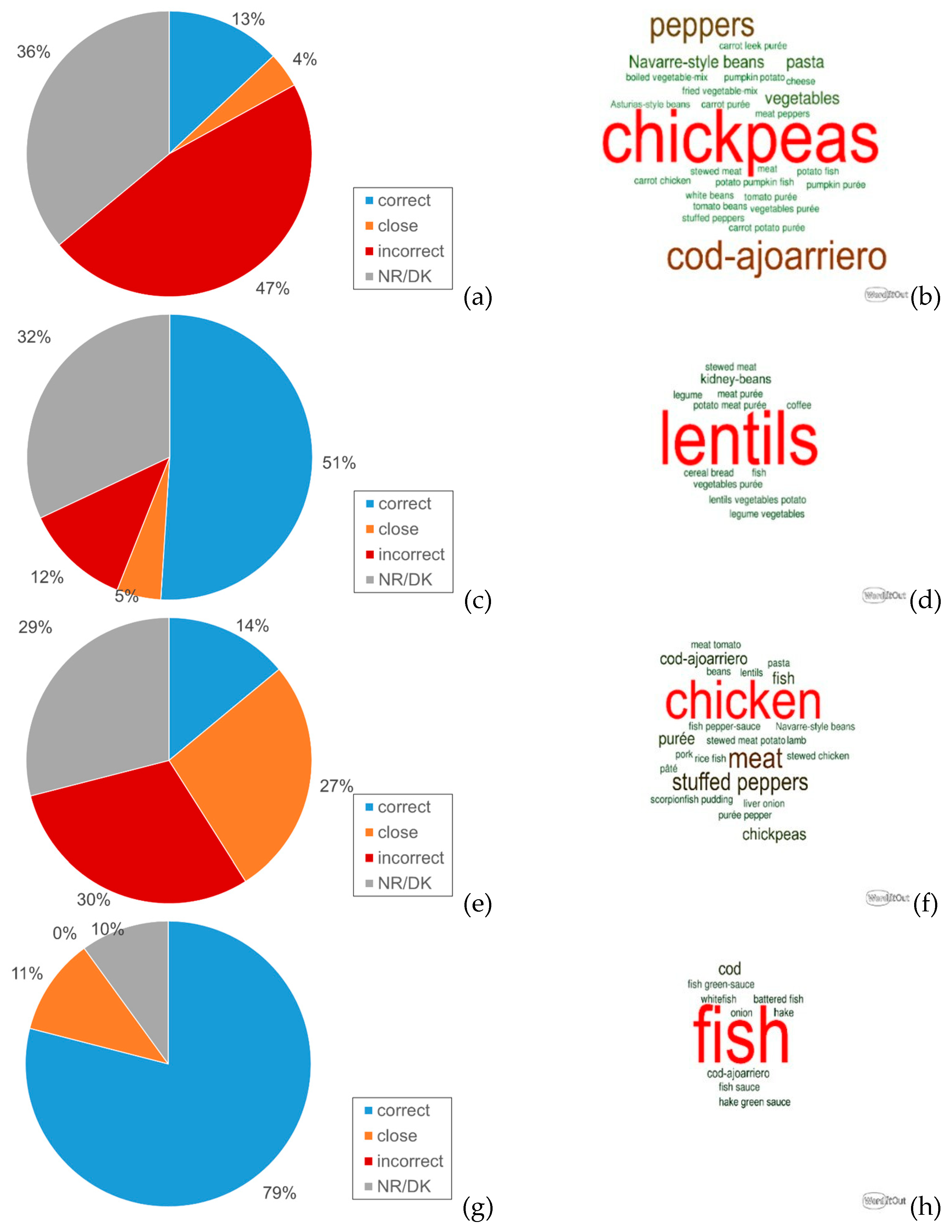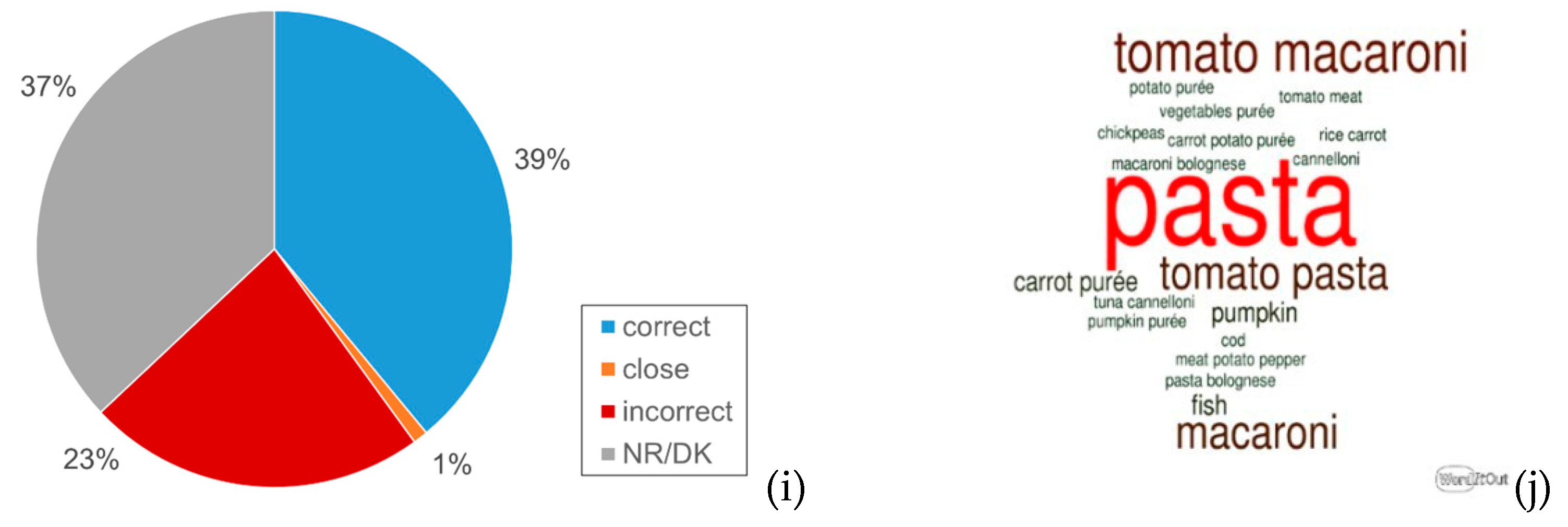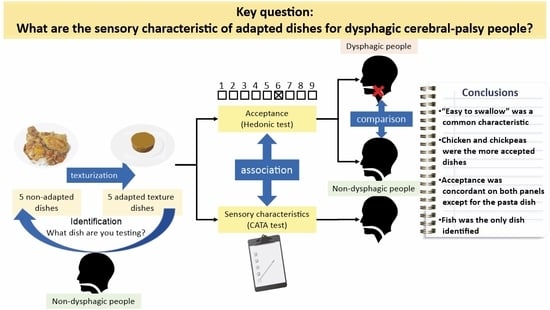Dishes Adapted to Dysphagia: Sensory Characteristics and Their Relationship to Hedonic Acceptance
Abstract
1. Introduction
2. Materials and Methods
2.1. Texture-Modified Dishes
2.2. Sensory Evaluation
2.2.1. Judges
2.2.2. Hedonic Evaluation
2.2.3. Selection of Attributes Using the CATA Method
2.2.4. Identification of the Original Non-Adapted Dishes
2.3. Statistical Analysis
3. Results
3.1. Hedonic Acceptance of Texture-Modified Dishes
3.2. Sensory Characteristics of Texture-Modified Dishes
3.3. Identification of Non-Adapted Dishes from Texture-Modified Dishes
4. Discussion
4.1. Hedonic Acceptance of Texture-Modified Dishes
4.2. Sensory Characteristics of Texture-Modified Dishes
4.3. Identification of Non-Adapted Dishes from Texture-Modified Dishes
5. Conclusions
Author Contributions
Funding
Institutional Review Board Statement
Informed Consent Statement
Data Availability Statement
Acknowledgments
Conflicts of Interest
Appendix A
| Hedonic Acceptance Level | Panel | Chickpea Stew | Lentils | Chicken Stew | Halibut with Green Sauce | Pasta Bolognese |
|---|---|---|---|---|---|---|
| Low | Dysphagic | 17.9 | 44.2 | 0.0 | 12.9 | 34.5 |
| Non-dysphagic | 6.7 | 31.7 | 5.0 | 15.0 | 19.3 | |
| Medium | Dysphagic | 17.9 | 25.6 | 27.5 | 25.8 | 10.3 |
| Non-dysphagic | 41.7 | 43.3 | 38.3 | 41.7 | 40.0 | |
| High | Dysphagic | 64.1 | 30.2 | 72.5 | 61.3 | 86.2 |
| Non-dysphagic | 51.7 | 25.0 | 56.7 | 43.3 | 41.7 |
| Liking Score | Salty | Flavorful | Bland | Strange Flavor | Fish Flavor | Meat Flavor | Metallic Taste | Leaves Residue | Sticky | Soft Texture | Thick Puree | Fish Odor | Meat Odor | Strange Odor | Mild Odor | Strong Odor | |
|---|---|---|---|---|---|---|---|---|---|---|---|---|---|---|---|---|---|
| Strong odor | −0.100 | 0.328 | −0.188 | −0.180 | 0.312 | 0.156 | 0.095 | 0.287 | 0.333 | −0.100 | −0.304 | 0.366 | 0.146 | −0.011 | 0.126 | −0.990 | |
| Mild odor | −0.005 | −0.269 | 0.179 | 0.455 | −0.094 | −0.393 | −0.057 | −0.318 | −0.283 | 0.227 | 0.184 | −0.108 | −0.575 | −0.307 | −0.553 | ||
| Strange odor | −0.181 | −0.760 | −0.353 | 0.122 | 0.735 | −0.344 | −0.848 | 0.192 | −0.023 | 0.024 | −0.220 | 0.153 | −0.856 | −0.824 | |||
| Meat odor | 0.132 | −0.013 | 0.334 | −0.275 | −0.880 | −0.907 | 0.819 | −0.783 | −0.830 | 0.061 | 0.075 | 0.053 | −0.89 | ||||
| Fish odor | 0.040 | 0.205 | −0.037 | −0.670 | −0.500 | 0.945 | −0.512 | −0.077 | 0.176 | −0.020 | −0.06 | 0.202 | |||||
| Thick puree | −0.173 | 0.057 | −0.286 | 0.086 | 0.240 | 0.117 | −0.101 | 0.026 | −0.128 | −0.060 | −0.560 | ||||||
| Soft texture | 0.307 | 0.04 | 0.306 | −0.018 | −0.172 | −0.037 | −0.090 | −0.246 | −0.056 | −0.370 | |||||||
| Sticky | −0.132 | −0.800 | −0.509 | 0.178 | 0.299 | −0.197 | 0.158 | 0.251 | −0.009 | ||||||||
| Leaves residue | 0.017 | 0.110 | −0.017 | −0.007 | −0.091 | 0.164 | −0.270 | 0.660 | |||||||||
| Metallic taste | −0.096 | −0.680 | −0.840 | 0.131 | −0.035 | −0.149 | −0.808 | ||||||||||
| Meat flavor | 0.042 | 0.091 | 0.063 | −0.129 | −0.344 | −0.925 | |||||||||||
| Fish flavor | 0.027 | 0.461 | 0.005 | −0.650 | −0.567 | ||||||||||||
| Strange flavor | −0.356 | −0.816 | −0.576 | 0.121 | |||||||||||||
| Bland | −0.259 | −0.278 | −0.952 | ||||||||||||||
| Flavorful | 0.426 | −0.032 | |||||||||||||||
| Salty | 0.008 | ||||||||||||||||
| Liking score | 1.00 | 0.008 | 0.426 | −0.260 | −0.356 | 0.027 | 0.042 | −0.096 | 0.017 | −0.130 | 0.307 | −0.173 | 0.04 | 0.132 | −0.181 | −0.005 | −0.100 |



References
- Sungsinchai, S.; Niamnuy, C.; Wattanapan, P.; Charoenchaitrakool, M.; Devahastin, S. Texture modification technologies and their opportunities for the production of dysphagia foods: A review. Compr. Rev. Food Sci. Food Saf. 2019. [Google Scholar] [CrossRef] [PubMed]
- Cichero, J.A.Y. Evaluating chewing function: Expanding the dysphagia field using food oral processing and the IDDSI framework. J. Texture Stud. 2020, 51, 56–66. [Google Scholar] [CrossRef] [PubMed]
- Okkels, S.L.; Saxosen, M.; Bügel, S.; Olsen, A.; Klausen, T.W.; Beck, A.M. Acceptance of texture-modified in-between-meals among old adults with dysphagia. Clin. Nutr. Espen 2018, 25, 126–132. [Google Scholar] [CrossRef]
- Manduchi, B.; Fainman, G.M.; Walshe, M. Interventions for feeding and swallowing disorders in adults with intellectual disability: A systematic review of the evidence. Dysphagia 2020, 35, 207–219. [Google Scholar] [CrossRef] [PubMed]
- Hastorf, C.A. The practices of a meal in society. In The Social Archaeology of Food: Thinking about Eating from Prehistory to the Present; Cambridge University Press: Cambridge, UK, 2016; pp. 55–80. ISBN 978-1-107-15336-3. [Google Scholar]
- Margasahayam, A.; Balraj, Y. Properties of food ingredients during processing in a domestic mixer grinder and subsequent storage: A review. J. Food Process Eng. 2018, 41, e12677. [Google Scholar] [CrossRef]
- Matta, Z.; Chambers, I.V.E.; Garcia, J.M.; Helverson, J.M. Sensory characteristics of beverages prepared with commercial thickeners used for dysphagia diets. J. Am. Diet. Assoc. 2006, 106, 1049–1054. [Google Scholar] [CrossRef]
- Ares, G.; Jaeger, S.R. Check-all-that-apply (CATA) questions with consumers in practice: Experimental considerations and impact on outcome. In Rapid Sensory Profiling Techniques; Delarue, J., Lawlor, J.B., Rogeaux, M., Eds.; Woodhead Publishing Series in Food Science, Technology and Nutrition; Woodhead Publishing: Sawston, UK; Cambridge, UK, 2015; pp. 227–245. ISBN 978-1-78242-248-8. [Google Scholar]
- Ares, G.; de Andrade, J.C.; Antúnez, L.; Alcaire, F.; Swaney-Stueve, M.; Gordon, S.; Jaeger, S.R. Hedonic product optimisation: CATA questions as alternatives to JAR scales. Food Qual. Prefer. 2017, 55, 67–78. [Google Scholar] [CrossRef]
- Sharma, M.; Duizer, L. Characterizing the dynamic textural properties of hydrocolloids in pureed foods—A comparison between TDS and TCATA. Foods 2019, 8, 184. [Google Scholar] [CrossRef]
- Yver, C.M.; Kennedy, W.P.; Mirza, N. Taste acceptability of thickening agents. World J. Otorhinolaryngol. Head Neck Surg. 2018, 4, 145–147. [Google Scholar] [CrossRef]
- Merino, G.; Gómez, I.; Marín-Arroyo, M.R.; Beriain, M.J.; Ibañez, F.C. Methodology for design of suitable dishes for dysphagic people. Innov. Food Sci. Emerg. Technol. 2020, 64, 102383. [Google Scholar] [CrossRef]
- ISO. Sensory Analysis General Guidance for the Design of Test. Rooms; International Organization for Standardization, Ed.; ISO: Geneve, Switzerland, 2007. [Google Scholar]
- Freeman, G.H. Complete latin squares and related experimental designs. J. R. Stat. Soc. Ser. B 1979, 41, 253–262. [Google Scholar] [CrossRef]
- López, M.C. Cuidadoras y Cuidadores: El Efecto del Género en el Cuidado no Profesional de los Mayores; Ministerio de Educación, Política Social y Deporte; Instituto de Mayores y Servicios Sociales: Madrid, Spain, 2008. [Google Scholar]
- Bernalte Martí, V. Minoría de hombres en la profesión de enfermería. Reflexiones sobre su historia, imagen y evolución en España. Eglobal 2015, 14, 328–334. [Google Scholar] [CrossRef][Green Version]
- O’Mahony, M. Sensory Evaluation of Food: Statistical Methods and Procedures; Routledge: New York, NY, USA, 1986; ISBN 978-0-203-73988-4. [Google Scholar]
- Tenenhaus, M.; Young, F.W. An analysis and synthesis of multiple correspondence analysis, optimal scaling, dual scaling, homogeneity analysis and other methods for quantifying categorical multivariate data. Psychometrika 1985, 50, 91–119. [Google Scholar] [CrossRef]
- Jolliffe, I.T. Principal Component Analysis, 2nd ed.; Springer Series in Statistics; Springer: New York, NY, USA, 2002; ISBN 978-0-387-95442-4. [Google Scholar]
- Graham, C.; Talay, D. Stochastic Simulation and Monte Carlo Methods: Mathematical Foundations of Stochastic Simulation; Stochastic Modelling and Applied Probability; Springer: Berlin/Heidelberg, Germany, 2013; ISBN 978-3-642-39362-4. [Google Scholar]
- Hoppu, U.; Hopia, A.; Pohjanheimo, T.; Rotola-Pukkila, M.; Mäkinen, S.; Pihlanto, A.; Sandell, M. Effect of salt reduction on consumer acceptance and sensory quality of food. Foods 2017, 6, 103. [Google Scholar] [CrossRef] [PubMed]
- Hall, G.; Wendin, K. Sensory design of foods for the elderly. Ann. Nutr. Metab. 2008, 52 (Suppl. S1), 25–28. [Google Scholar] [CrossRef]
- Houjaij, N.; Dufresne, T.; Lachance, N.; Ramaswamy, H.S. Textural characterization of pureed cakes prepared for the therapeutic treatment of dysphagic patients. Int. J. Food Prop. 2009, 12, 45–54. [Google Scholar] [CrossRef]
- Ilhamto, N.; Anciado, K.; Keller, H.H.; Duizer, L.M. In-house pureed food production in long-term care: Perspectives of dietary staff and implications for improvement. J. Nutr. Gerontol. Geriatr. 2014, 33, 210–228. [Google Scholar] [CrossRef] [PubMed]
- Fondberg, R.; Lundström, J.N.; Blöchl, M.; Olsson, M.J.; Seubert, J. Multisensory flavor perception: The relationship between congruency, pleasantness, and odor referral to the mouth. Appetite 2018, 125, 244–252. [Google Scholar] [CrossRef] [PubMed]
- Cavicchi, A.; Santini, C. Case Studies in the Traditional Food Sector, 1st ed.; Woodhead Publishing: Sawston, UK; Cambridge, UK, 2017; ISBN 978-0-08-101007-5. [Google Scholar]
- Nakatsu, S.; Kohyama, K.; Watanabe, Y.; Shibata, K.; Sakamoto, K.; Shimoda, M. Mechanical properties of softened foodstuffs processed by freeze–thaw infusion of macerating enzyme. Innov. Food Sci. Emerg. Technol. 2012, 16, 267–276. [Google Scholar] [CrossRef]
- Gössinger, M.; Buchmayer, S.; Greil, A.; Griesbacher, S.; Kainz, E.; Ledinegg, M.; Leitner, M.; Mantler, A.; Hanz, K.; Bauer, R.; et al. Effect of xanthan gum on typicity and flavour intensity of cloudy apple juice. J. Food Process. Preserv. 2018, 42, e13737. [Google Scholar] [CrossRef]
- Cichero, J.A.Y.; Steele, C.; Duivestein, J.; Clavé, P.; Chen, J.; Kayashita, J.; Dantas, R.; Lecko, C.; Speyer, R.; Lam, P.; et al. The need for international terminology and definitions for texture-modified foods and thickened liquids used in dysphagia management: Foundations of a global initiative. Curr. Phys Med. Rehabil. Rep. 2013, 1, 280–291. [Google Scholar] [CrossRef]
- Lepore, J.R.; Sims, C.A.; Gal, N.J.; Dahl, W.J. Acceptability and identification of scooped versus molded puréed foods. J. Diet. Pract. Res. Vol. 2014, 75. [Google Scholar] [CrossRef]
- Machado, A.S.; Vargens, K.L.; Armini, T.F.; Pereira, T.C.; Lenz, D.; Endringer, D.C. Food characteristics and oropharyngeal dysphagia: What speech therapists say. J. Sens. Stud. 2020, e12561. [Google Scholar] [CrossRef]
- Cook, S.L.; Bull, S.P.; Methven, L.; Parker, J.K.; Khutoryanskiy, V.V. Mucoadhesion: A food perspective. Food Hydrocoll. 2017, 72, 281–296. [Google Scholar] [CrossRef]
- Nakashima, T.; Suzuki, H.; Sugiura, S.; Beppu, R.; Ishida, K. Gustatory function in persons with cerebral palsy. J. Oral Rehabil. 2020, 47, 523–527. [Google Scholar] [CrossRef] [PubMed]
- Keller, H.H.; Duizer, L.M. What do consumers think of pureed food? Making the most of the indistinguishable food. J. Nutr. Gerontol. Geriatr. 2014, 33, 139–159. [Google Scholar] [CrossRef]
- Mansur, M.A.; Hossain, M.I.; Takamura, H.; Matoba, T. Flavour components of some processed fish and fishery products of Japan. Bangladesh J. Fish. Res. 2002, 6, 89–97. [Google Scholar]
- Halim, J.; Bouzari, A.; Felder, D.; Guinard, J. The Salt Flip: Sensory mitigation of salt (and sodium) reduction with monosodium glutamate (MSG) in “Better-for-You” foods. J. Food Sci. 2020. [Google Scholar] [CrossRef]
- Mosca, A.C.; Chen, J. Food-saliva interactions: Mechanisms and implications. Trends Food Sci. Technol. 2017, 66, 125–134. [Google Scholar] [CrossRef]
- Maughan, C.; Martini, S. Identification and quantification of flavor attributes present in chicken, lamb, pork, beef, and turkey. J. Food Sci. 2012, 77, S115–S121. [Google Scholar] [CrossRef] [PubMed]
- Menezes, E.A.; Oliveira, A.F.; França, C.J.; Souza, G.B.; Nogueira, A.R.A. Bioaccessibility of Ca, Cu, Fe, Mg, Zn, and crude protein in beef, pork and chicken after thermal processing. Food Chem. 2018, 240, 75–83. [Google Scholar] [CrossRef] [PubMed]
- Choichuedee, P.; Suttisansanee, U.; Hudthagosol, C.; Sanporkha, P. Sweet sticky rice puree diet for elderly with dysphagia. Walailak J. Sci. Technol. 2018, 17, 47–54. [Google Scholar] [CrossRef]
- Lee, N.; Kwak, H.S.; Joo, J.; Kang, J.; Lee, Y. Effects of partial replacement of pork meat with chicken or duck meat on the texture, flavor, and consumer acceptance of sausage. J. Food Qual. 2018, 2018, 1–9. [Google Scholar] [CrossRef]
- Hearst, M.A.; Pedersen, E.; Patil, L.; Lee, E.; Laskowski, P.; Franconeri, S. An evaluation of semantically grouped word cloud designs. IEEE Trans. Vis. Comput. Graph. 2020, 26, 2748–2761. [Google Scholar] [CrossRef] [PubMed]
- Ramdath, D.D.; Wolever, T.M.S.; Siow, Y.C.; Ryland, D.; Hawke, A.; Taylor, C.; Zahradka, P.; Aliani, M. Effect of processing on postprandial glycemic response and consumer acceptability of lentil-containing food items. Foods 2018, 7, 76. [Google Scholar] [CrossRef]
- Dandachy, S.; Mawlawi, H.; Obeid, O. Effect of processed chickpea flour incorporation on sensory properties of mankoushe zaatar. Foods 2019, 8, 151. [Google Scholar] [CrossRef] [PubMed]




| Dish | Hedonic Score |
|---|---|
| Chickpea stew | 6.4 (1.7) a,b |
| Lentils with rice | 4.7 (2.3) d |
| Chicken stew | 6.6 (1.7) a |
| Halibut with green sauce | 5.8 (2.1) b,c |
| Pasta bolognese | 5.5 (2.1) c |
| Hedonic Acceptance Level | Test | Chickpea Stew | Lentils with Rice | Chicken Stew | Halibut with Green Sauce | Pasta Bolognese |
|---|---|---|---|---|---|---|
| Low | χ2 | 0.081 | 0.194 | 0.151 | 0.786 | 0.054 |
| Monte-Carlo | 0.110 | 0.212 | 0.259 | 1.000 | 0.095 | |
| Medium | χ2 | 0.014 | 0.064 | 0.263 | 0.136 | 0.004 |
| Monte-Carlo | 0.017 | 0.086 | 0.285 | 0.163 | 0.008 | |
| High | χ2 | 0.223 | 0.556 | 0.108 | 0.104 | <0.0001 |
| Monte-Carlo | 0.294 | 0.661 | 0.143 | 0.124 | <0.0001 |
| Phase | Attributes | Chickpea Stew | Lentils with Rice | Chicken Stew | Halibut with Green Sauce | Pasta Bolognese | p-Value |
|---|---|---|---|---|---|---|---|
| Olfactory | Strong odor | 3 b | 19 a | 9 a,b | 14 a,b | 7 a,b | 0.000 |
| Mild odor | 55 a | 29 b,c | 33 b | 18 c | 44 a,b | <0.0001 | |
| Original dish odor | 13 | 18 | 17 | 21 | 21 | 0.263 | |
| Strange odor | 2 b | 12 a | 3 b | 1 b | 4 b | 0.002 | |
| Meat odor | 6 b | 3 b | 25 a | 1 b | 2 b | <0.0001 | |
| Fish odor | 1 b | 2 b | 8 b | 47 a | 2 b | <0.0001 | |
| Visual | Heterogeneous aspect | 1 | 6 | 4 | 6 | 1 | 0.205 |
| Homogeneous aspect | 66 | 60 | 61 | 58 | 64 | 0.130 | |
| Oral | Thick puree | 18 b | 39 b | 19 b | 21 a,b | 19 b | 0.001 |
| Lumpy | 1 | 6 | 3 | 6 | 2 | 0.259 | |
| Fibrous | 1 | 3 | 0 | 1 | 0 | 0.075 | |
| Floury | 12 | 23 | 15 | 1 | 8 | 0.059 | |
| Soft texture | 40 a | 17 b | 34 a,b | 32 a,b | 39 a | 0.000 | |
| Liquid puree | 0 | 1 | 0 | 0 | 0 | 0.406 | |
| Sticky | 4 b | 5 a,b | 4 b | 4 b | 19 a | 0.000 | |
| Leave residue | 2 b | 9 a | 1 b | 6 a | 1 b | 0.006 | |
| Bolus-forming | 3 | 2 | 3 | 0 | 1 | 0.216 | |
| It spreads | 5 | 3 | 5 | 8 | 8 | 0.406 | |
| Easy to swallow | 44 | 32 | 42 | 45 | 32 | 0.086 | |
| Hard to swallow | 0 | 6 | 4 | 1 | 5 | 0.113 | |
| Gustatory | Metallic taste | 0 b | 5 a | 0 b | 1 b | 2 b | 0.030 |
| Meat flavor | 9 b | 4 b | 30 a | 0 b | 5 b | <0.0001 | |
| Original dish flavor | 24 | 29 | 23 | 28 | 24 | 0.719 | |
| Fish flavor | 2 b | 3 b | 8 b | 60 a | 2 b | <0.0001 | |
| Strange flavor | 8 a,b | 17 a | 5 a,b | 1 b | 15 a | 0.000 | |
| Bland | 19 b | 35 a | 3 c | 2 c | 31 a,b | <0.0001 | |
| Flavorful | 24 a,b | 2 d | 31 a | 13 b,c | 6 c,d | <0.0001 | |
| Salty | 0 b | 0 b | 4 a,b | 7 a | 1 b | 0.021 |
Publisher’s Note: MDPI stays neutral with regard to jurisdictional claims in published maps and institutional affiliations. |
© 2021 by the authors. Licensee MDPI, Basel, Switzerland. This article is an open access article distributed under the terms and conditions of the Creative Commons Attribution (CC BY) license (http://creativecommons.org/licenses/by/4.0/).
Share and Cite
Merino, G.; Marín-Arroyo, M.R.; Beriain, M.J.; Ibañez, F.C. Dishes Adapted to Dysphagia: Sensory Characteristics and Their Relationship to Hedonic Acceptance. Foods 2021, 10, 480. https://doi.org/10.3390/foods10020480
Merino G, Marín-Arroyo MR, Beriain MJ, Ibañez FC. Dishes Adapted to Dysphagia: Sensory Characteristics and Their Relationship to Hedonic Acceptance. Foods. 2021; 10(2):480. https://doi.org/10.3390/foods10020480
Chicago/Turabian StyleMerino, Gorka, Maria Remedios Marín-Arroyo, María José Beriain, and Francisco C. Ibañez. 2021. "Dishes Adapted to Dysphagia: Sensory Characteristics and Their Relationship to Hedonic Acceptance" Foods 10, no. 2: 480. https://doi.org/10.3390/foods10020480
APA StyleMerino, G., Marín-Arroyo, M. R., Beriain, M. J., & Ibañez, F. C. (2021). Dishes Adapted to Dysphagia: Sensory Characteristics and Their Relationship to Hedonic Acceptance. Foods, 10(2), 480. https://doi.org/10.3390/foods10020480







